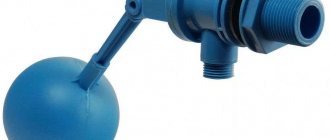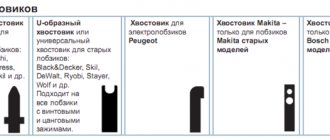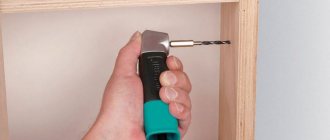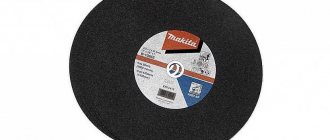Punchers, hole punchers and cutters are structurally different tools in leatherwork, but have a common purpose - making holes in materials. They are also capable of performing many types of work related to the preparation of various dense materials and leather for stitching. These materials, as a rule, have great rigidity, which makes working with them without the devices in question extremely difficult. Moreover, some manipulations without them cannot even be performed at all. Punchers can be used not only on fabric and leather, but also on tarpaulin and leatherette. The holes they make are smooth and of higher quality than when carrying out similar operations with a sewing needle, drill or awl.
Classification and device
Due to the fact that leather has a high density, a needle or awl is not always suitable for punching it. From here it is clear that for greater efficiency you should use a special tool (punchers and hole punchers), the models of which can be divided into:
- Lowercase;
- Curly;
- Revolver;
- Ring;
- End
A standard punch is a tube with a sharpened working surface. Sharp sharpening is the main design requirement, based on the fact that the smaller the area the device is in contact with the material, the easier it is to make holes in it.
IMPORTANT! It is quite possible to make a hole-punching and punching device yourself; you just need to select a tube of the required diameter and sharpen it with high quality.
There are also modern models that have a countersinking function. For such samples, the work cycle consists of two steps:
- The tip punches a hole;
- Special built-in blades expand the opening to a given size.
The countersinking process itself is a mechanical processing of the material, in which the accuracy of the hole being punched is calculated in tenths of a millimeter. Performing such manipulations manually is practically impossible, because It will be necessary to apply excessive muscular effort to the device, maintaining increased accuracy. In a countersink, various metalworking machines can be used as a working drive. The shape of the hole will depend on the working part of the hole punch. As an example, we can give a conical shape of a tool, the impact of which will produce round holes.
Models for eyelets
To install eyelets (fittings that protect holes from destruction) on the material, you will need to make round holes with a certain diameter. It is very difficult to perform such an operation using improvised tools or at home. Therefore, for this process, special devices are used, which, when making holes, simultaneously attach special rims to their edges, protecting the edges of the holes from destruction. Typically, such rivets may also contain the branding of the manufacturing company or its proprietary pattern. Eyelet models not only perforate products, but can also simultaneously bend the edges of holes, which in the future will not require special processing of their edges.
Linear models
Their shape can be compared to a comb or a dinner fork. They have special spikes that are arranged in a single line, standing at an equidistant distance from each other. This device contains needles ranging from two to six pieces. They are installed on the same line along which the future seam will pass. By striking the end part of the device, the material being processed is pierced and holes are made in it. The number of spikes on the line punch will determine the sewing speed. Upon completion of penetration, the spikes are removed from the holes, and the comb itself is shifted the required distance to one side, maintaining an even step. Line punchers can be divided into two options:
- Products that work on the principle of a cutter, pressing/piercing holes, and pushing the material apart;
- Products that cut out a small cavity in the material, removing the resulting excess (this option leaves the highest quality and neatest holes).
It is worth noting that for inline models, the spikes may have different shapes. The most common are round and semicircular options, but there are also:
- Diamond-shaped;
- Triangular;
- Oblique;
- Rectangular.
IMPORTANT! An important role in the work of urgent samples is played by the thickness of the cross-section of the spikes and the distance between them. For example, French seams are usually made using bias punches and they are traditionally used for sewing purses or finishing leather watch straps.
If you plan to work with very coarse and dense material, then it is preferable to use cutters whose spikes have a larger diameter and increased spacing. This ratio will allow you to stitch the future product with thicker threads. It should be noted that for this category there is no universal toolkit suitable for all working situations, therefore, the more different line combs a master has, the greater the range of tasks he can perform.
IMPORTANT! The diamond-shaped shape of the studs is characteristic of the Chinese tailoring school, which has developed historically. Their line punches classically have 1, 2, 4, 6 teeth with a standard distance between them of 5 millimeters.
Revolver models
In appearance, the devices in question resemble pliers, on one part of which a revolver-type device is installed for punching holes. Using such a sample, you need to turn the device and install the working spike of the desired type. Next, all that remains is to place the material to be processed and press the handle to make the hole. As a standard, revolving models have six studs with a diameter of 2 to 4.5 millimeters. The risk of the drum spinning during operation is prevented by a special blocker. However, one press of this model means making one hole, which means it is not possible to get a seam right away. The main purpose of revolving devices is to punch single holes, for example, for a waist belt or a bag strap.
Curly models
Punching holes using ring or shaped devices involves removing part of the material that falls under their working part. With the help of such devices it is possible to make large-sized slots. Their traditional shape is a regular tube with a pointed end. Cutting is carried out by applying the pointed part to the material and hitting the end of the tool with a strong blow. The range in this model range is very large. Thanks to them, it is possible to make not only an oval or round hole, but also to repeat the outlines of complex geometric shapes - stars, polygons, trapezoids, etc. The models under consideration are usually supplied in kits where the tubes have a diameter from 2 to 22 millimeters.
End models
They are most often used for trimming skin. Special trimmers used for processing belts, shaped like a curved steel plate, have become very popular. This plate is convenient for cutting ribbons for waist belts.
"Hunting" models
With their help, wads are specially cut, which are subsequently inserted into the cartridge. They have large-sized shapes, compared to sartorial variations. Their diameter corresponds to the caliber of the cartridge loaded with the wad. Their main purpose is to cut out the desired piece from a very dense material, which is usually cork, cardboard or felt.
Special models
These variations are equipment capable of working both on leather and thick fabric, and on metal. This may include:
- Pneumatic - such samples require connection to a pneumatic compressor. They are used for processing various materials, including tin, sheet metal or metal tiles.
- Hydraulic - they are, to a greater extent, similar in principle of operation and appearance to industrial machines designed for making holes in metal.
- Manual - these variations for dense materials will require remarkable strength from the master. Their body itself is always made of durable carbon steel, due to the specific nature of processing dense products. Due to their massive construction, they are less susceptible to deformation when cutting into the workpiece.
IMPORTANT! Special models can lose their sharpness very quickly, so a periodic sharpening procedure is provided for them. In this case, you need to sharpen the working part not only on the outside, but also on the inside, completing this process with polishing.
Top leather belt
Hi all. I made myself a gift, an English Bridle leather belt from the J&FJ Baker factory (England).
In general, I don't know how to take pictures. But the skin is very cool. For all questions, write in the comments, or on my Instagram page: https://www.instagram.com/sasha_bezak_/?hl=ru I will be glad to have new subscribers
Greetings! I thought why not make a wallet, but one that was not simple, but special in its own way. The choice fell on biker wallets. They attract people with their brutality, functionality and ample scope for creativity. A more or less classic model was taken as a basis, but it was decided to draw everything from scratch. And since the theme is biker, then the leather should be appropriate. Horween horse leather has been produced in the USA at the factory of the same name for over 100 years. A concho button with the image of an Indian that has already become a classic for the Wild West, but in the original interpretation of the author. Brass, smooth contrasting seams with fine pitches and other details, I think, gave it its own unique, original look.
Basics of using hole punches and punches
First of all, you should choose the right tool. Its pitch, the diameter of the piercing working part and the material of manufacture must correspond to the current task. Then you need to:
- On the existing workpiece, mark the location of the future hole;
- Install the tool in such a way that its working part fits tightly into the future hole, without going beyond the required limits;
- It is important to maintain the spacing between holes in a uniform manner, and all marks must be located on the same line;
- Having accurately checked all the measurements, the tool is applied to the workpiece and its activating element is pressed (for end tools - a blow to the end, for revolving tools - squeezing the handles, etc.). The pressure force must correspond to the density of the material;
- After pressing, it is necessary to remove the cut out element of the workpiece or clean the resulting hole.
When using the equipment in question, selection of the interval and centering of the tool are considered important conditions. If these conditions are in “disagreement” with each other, then the holes may not be on the same line. When punching the first hole (or set of holes), you need to constantly maintain the spacing and direction, then the resulting result will be indistinguishable from factory work. The processing principles described above are applicable not only for punching holes, but also for installing buttons and rivets.
IMPORTANT! The tool will last much longer if you put a special substrate in the form of a polymer plate under the workpiece. Removing the workpiece at the end of the work must be done vertically, avoiding its swinging.
Case Stalker
Good afternoon. I would like to share the process of creating such a case based on the game Stalker.
The case was ordered as a gift for a fan of the game. I already made a case with a radiation sign in this post.
I ordered the very base of the case from Aliexpress, this time I chose a thermoplastic polyurethane case instead of plastic so that the case would last longer.
I cut out the required pieces of leather, crease it, process the end and glue it to the leather cardboard.
I cut through all the letters and the radiation sign, painted over the ends inside the letters once.
I glued another layer of leather cardboard and painted over the letters with the sign. It turned out to be about 5-6 layers, since the paint shrinks a lot.
I cut out the workpiece and punched holes for the seam. The hole pitch is 3.38mm, the thread will be 0.45mm
The result is a case like this for the Samsung A50
Thank you for your attention, I will be happy to answer your questions in the comments and by email
Making your own stepper punch
The stepping tool is rightfully considered one of the main devices for working with leather, which is used to make holes when sewing workpieces. It is possible to use a regular table fork as a structural base for it. It is preferable to choose the latter from stainless steel (not aluminum) with a flat handle. Its teeth should preferably be rectangular or triangular.
First you need to get rid of the curvature of the teeth by aligning them. To do this, you need to heat the working part over the fire, after holding the fork handle in a vice, and knock on the teeth with a hammer. Next, the teeth are carefully filed using a hacksaw, and then broken off using pliers. Also, the excess part of the handle is sawed off with a hacksaw in order to give it an even shape of the end for impact, and the sharp edge formed along the edges is cleaned with a file. The next step will be the process of equalizing the width of the fork tines, because the outer tines of the fork are slightly wider than the middle ones.
At the last stage, it is necessary to sharpen the working elements of the device with a needle file, checking that the length of the teeth is uniform, otherwise the size and shape of the holes being punched will differ.
Before using the resulting device, it is necessary to check the quality of future holes on unnecessary scraps of leather blanks. If adjustment is necessary, it must be done by sharpening the working teeth.
It is worth noting that for the handle it is possible to use a part of another tool that has become unusable with a suitable size in order to ensure complete convenience of striking the end part, with proper distribution and application of the impact force across all teeth.
Simple bifold made of genuine leather
Hello everyone, the other day I was working on a pattern for a new wallet and captured a little of the process.
The model is simple and widespread on the Internet, but I modified it to suit myself, reducing the dimensions. The wallet has 6 pockets for cards and one large compartment for bills.
A little about the process: Printed out the pattern, pasted it on thick paper, cut it out.
Then I secured it to the skin with masking tape and marked the outlines with holes.
I cut out holes, went through the edges with a creasing machine, and sewed the pockets.
I sewed the pockets to the inside and stitched the piece where it would not meet the front side.
I glued the resulting parts together, stitched them with a saddle stitch, sanded them, and then painted the ends. And this is what happened in the end:
Some technical characteristics: Italian buttero leather in two colors, thickness 1.2 mm, thread 0.5, punch pitch 3.85. I polished the ends with toconol, painted the top and applied hard wax.
The pattern, according to tradition, is posted in the discussions of my group:
Thank you for attention.
Difficulty of choice
When working with leather, most novice craftsmen ask themselves the question: which punching equipment should they prefer? The choice of high-quality tools will allow you to quickly and efficiently mark the workpiece, cut out and pierce holes, while simultaneously selecting their proper shapes and sizes. Therefore, when choosing, you need to follow a few simple rules:
- The oval model is great for most leatherworking projects, from making multiple holes in a waist belt to single handbag applications;
- Figured models are a design tool, because with their help complex geometry is created: crescents, flowers, drops and even butterflies;
- Inline models are suitable for many options for hole lacing sets.
Most professionals prefer to often use round die-cut hole punches with a pitch of 4-5 millimeters, and in special cases, use a not too expensive diamond-shaped set. When purchasing, you need to pay attention to the quality of the teeth - whether they are polished or not. Working with a punch whose teeth are polished will be somewhat faster, since it will be easier for it to penetrate the workpiece than unpolished teeth, which will cling to the edges of the holes. Polished samples are an order of magnitude more expensive than their unpolished counterparts. However, if a one-time job is intended, then it is possible to get by with an unpolished tool.
It is worth noting that devices manufactured in Japan, Germany and the USA are more popular. Chinese devices, although they are very cheap, often do not have even the minimum necessary qualities. The best manufacturing material for the tools in question is durable alloy steel. As for sharpening the working teeth, it would be better if they were subjected to diamond processing or additional hardening.
Leather punch - how to use, types of punches, personal experience of a leatherworker
Any master at the beginning of his journey in leatherworking was faced with the difficulty of which leather punch to choose. I, too, when I started working with leather, was very lost in all these options, I didn’t understand how round punches differ from diamond-shaped ones, what a reverse punch means and why it is needed, what pitch and diameter to choose.
In general, it seemed to me then that this was all very difficult and choosing a tool for punching holes in the skin was not at all possible for a beginner.
But with time and experience, you understand which set of leather punches is right for you.
Article navigation
I want to say right away that there are no “right” or “wrong” options for leather punches. Each one is unique in its own way and the master can choose any one depending on his wishes and style. This article will be useful for both beginners and experienced craftsmen; in it we will look at the types of punches, how they differ, what step is needed for what, and where you can buy them. I will also tell you directly about my experience and what punches I use myself.
Instead of an epilogue
A review of the modern market for the devices in question has established that in almost all segments it contains products from foreign manufacturers. At the same time, it is quite capable of meeting the stated prices in terms of its quality, although the prices may seem quite high. It is recommended to purchase such tools through online stores, because in them you can find a sufficient assortment that can satisfy both a professional craftsman and an amateur. As for the brands of manufacturing countries, I would like to note German companies that have all the good characteristics of the goods they supply, and, unlike others, they try to fill the market not with individual tools, but with fairly expanded sets. The Russian manufacturer is not even represented with its own products, however, it produces goods of decent quality under an American license.
Fire Bringer Bracelet
-Genuine vegetable tanned leather 3mm
-Penetrating black paint.
-Acrylic paints for leather.
- Means for processing bakhtarma.
One nice pick-up guy, having seen a photo of a finished fox bracelet in a box with filling, said: “They look like they’re dancing in a fire.”
And I was carried away. I love fire. At one time I was naturally obsessed with him and dyed my hair red for quite a long time in order to look at least a little like him.
So, after hearing this, I immediately took up the sketch, and then the creation of this bracelet.
The photo below shows the sketch and embossing. I wanted dynamics, passion and asymmetry.
I was very lucky - the other day the sun came out and I was able to take a photo in contrasting warm lighting. In my opinion, the sun suits the fire theme well.
And here is the photo that was mentioned at the beginning of the post.











